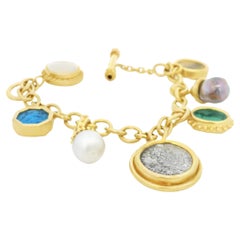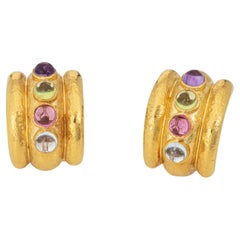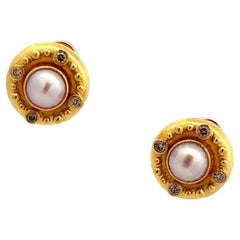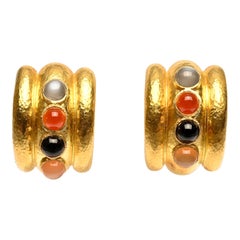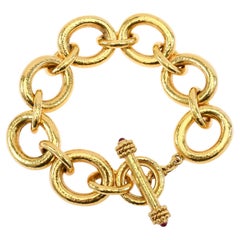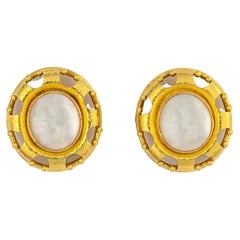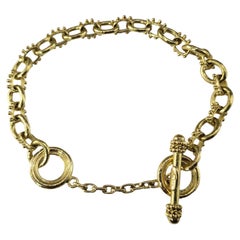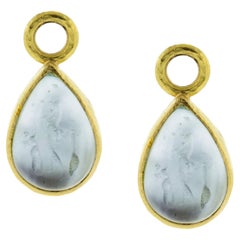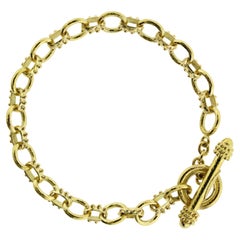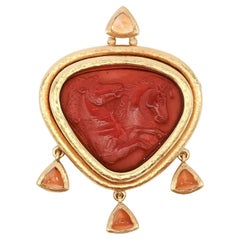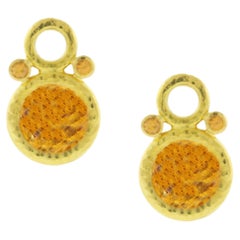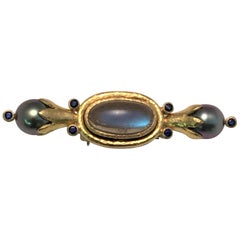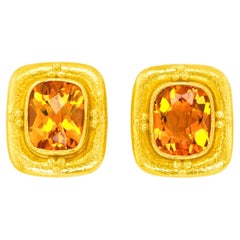Elizabeth Locke
Venetian-glass intaglios, ancient Greek and Roman coins, antique porcelain buttons and other treasures that Elizabeth Locke collects from around the world all inspire and are incorporated into her earrings, necklaces and other handmade designs.
The Virginia-based jeweler began her journey as a collector after she’d already launched her namesake jewelry line, and her assemblage of micromosaics, which are essentially miniature plaques composed of enameled-glass tesserae, were the subject of the 2020–21 exhibition “A Return to the Grand Tour: Micromosaic Jewels from the Collection of Elizabeth Locke” at the Virginia Museum of Fine Arts.
“They’re very hard to find, and you never know where you’ll see them,” Locke explains of micromosaics, the magnificent, miniature works for which she’s had to navigate lesser-known antique shops and auctions and build relationships with private dealers in Europe.
All of Locke’s imaginative jewelry pieces see an integration of rare and eclectic materials, the kind that might’ve been amassed during a 19th-century Grand Tour of Europe, when these coming-of-age journeys had long been popular (mostly for wealthy European men). Working in a neoclassical style, Locke references history with a modern approach for her moonstone earrings, gold-link bracelets, Venetian-glass pendants and other distinctive accessories. As she told W magazine, “Jewelry is designed for the era in which it is worn.”
In 1988, as an editor for Town & Country, Locke traveled to Bangkok to write about making jewelry. Unexpectedly, she found her niche. Upon her return home, Locke enrolled in the Gemological Institute of America and began sketching ideas. By 1990, her tourmaline ring — crafted with the goldsmiths she had met in Bangkok and who she would continue to collaborate with over the following decades — landed the cover of W.
Locke’s handmade, 19-karat-gold designs give one-of-a-kind antiquities new meaning in the 21st century. Not one to follow trends, Locke prefers designs that express a unique vision. “I know what I can do and I know what I feel comfortable doing, and I stick to it,” she has said.
Find a collection of Elizabeth Locke’s jewelry on 1stDibs.
| Average Sold Price |
| $4,212 |
| Styles |
| Related Creators |
20th Century American Contemporary Elizabeth Locke
Pearl, Cultured Pearl, 18k Gold, Yellow Gold
21st Century and Contemporary Unknown Contemporary Elizabeth Locke
Amethyst, Aquamarine, Tourmaline, Gold, 18k Gold, Yellow Gold
21st Century and Contemporary British Modern Elizabeth Locke
Diamond, Pearl, Gold, 18k Gold, Yellow Gold
Early 2000s American Contemporary Elizabeth Locke
Amethyst, Carnelian, Chalcedony, Quartz, 18k Gold
2010s American Contemporary Elizabeth Locke
Citrine, Gold, 18k Gold
Late 20th Century American Contemporary Elizabeth Locke
18k Gold
20th Century Elizabeth Locke
18k Gold, Yellow Gold
2010s Elizabeth Locke
Popular Searches
Elizabeth Locke Sale Prices
| Sold Date | Sold Price | Category | Material | Creation Year | ||||||||||||||||||||||||||||||||||||||||||||||||||||||||
|
| $4,212 |
Average sold price of items in the past 12 months |
| $2,500-$8,250 |
| Sold price range of items in the past 12 months |
Creators Similar to Elizabeth Locke
Elizabeth Locke jewelry & watches for sale on 1stDibs.
- 1stDibs ExpertJanuary 19, 2025Elizabeth Locke jewelry is made in a few locations. The luxury maker produces pieces in London, UK; Venice, Italy, and Bangkok, Thailand. As for Locke herself, she is based in Virginia. Her handmade, 19-karat-gold designs give one-of-a-kind antiquities new meaning in the 21st century. Shop a range of Elizabeth Locke jewelry on 1stDibs.
